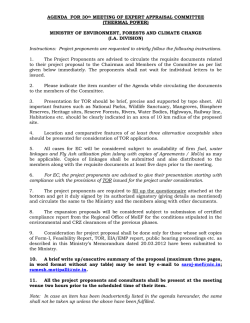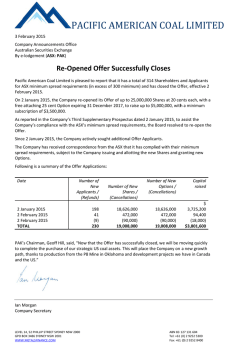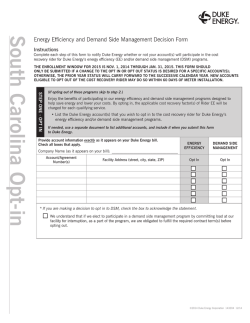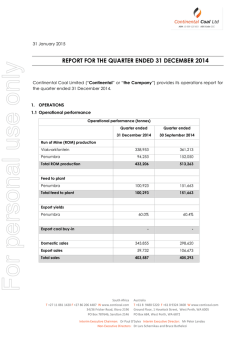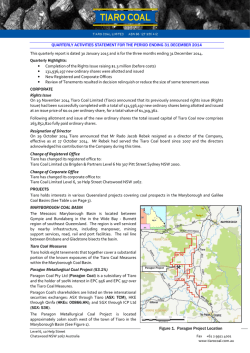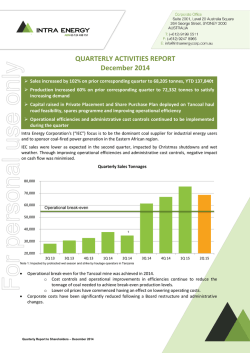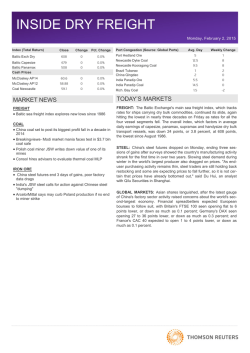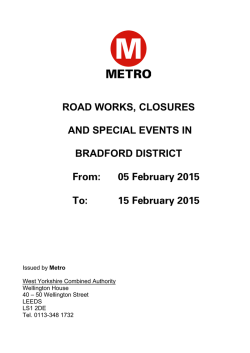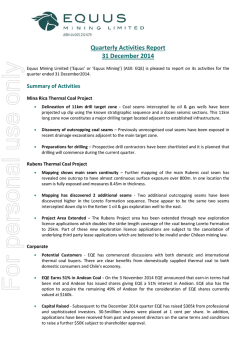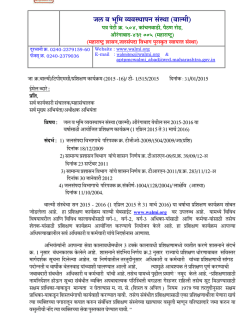
make final determinations
Heather Hillaker University of North Carolina School of Law J.D. Candidate, Class of 2015 [email protected] Summary of the Coal Ash Management Act The purpose of this memorandum is to present and summarize a new piece of legislation—the Coal Ash Management Act (“the Act”)—in order to facilitate an understanding of how the Act impacts many regulatory areas in new ways. For example, coal ash will now be regulated as a solid waste unless it is being used in structural fill or other beneficial uses, effectively placing new standards on the management of coal ash that have not applied before now.1 This memorandum provides a basic summary of changes and next steps in the regulation of coal ash, with references to the legislation’s section and page numbers and a compilation of all deadlines attached in Appendix A. I. Coal Ash Management Commission [Section 3(a); pg. 4–6] The Act creates an independent Coal Ash Management Commission (“CAMC”) to be located within the Department of Public Safety (“DPS”). The CAMC will consist of nine members: six appointed by the General Assembly and three, including the Chair, appointed by the Governor.2 The Act charges the CAMC with the following responsibilities: (1) review and approve coal ash impoundment classifications;3 (2) review and approve closure plans;4 (3) review and make recommendations on rules related to the management of coal ash; and (4) undertake studies requested by the General Assembly.5 In order to perform these duties and responsibilities, the CAMC is provided with five staff positions in Part IX of the Act and is given the authority to hire additional staff for assistance.6 II. Disposal [Section 3(a); pg. 9] The Act sets forth deadlines after which certain activities are prohibited: 1 Sect. 3(d); pg. 31. Sect. 3(a); pg. 4–5. 3 Impoundment classifications are discussed in Part III.A. of this summary. 4 Closure Plans are discussed in Part III.B. of this summary. 5 Studies are discussed in Part VI.J. of this summary. 6 Sect. 3(a); pg. 5–6 & Sect. 15(d); pg. 44. 2 1 Oct. 1, 2014 – Prohibition on construction of new and expansion of existing coal ash impoundments Oct. 1, 2014 – Prohibition on disposal of coal combustion residuals (“coal ash” or “residuals”) into an impoundment at facilities that are no longer producing coal ash Dec. 31, 2018 – Prohibition on the discharge of stormwater into an impoundment at facilities that are no longer producing coal ash Dec. 31, 2018 – Deadline for all facilities to convert to the disposal of “dry” fly ash or retire the facility Dec. 31, 2019 – Prohibition on the discharge of stormwater into an impoundment at facilities that are actively producing coal ash Dec. 31, 2019 – Deadline for all facilities to convert to the disposal of “dry” bottom ash or retire the facility Please consult the timeline in Appendix A for more details. 7 III. Cleanup A. Prioritization [Section 3(a)–(c); pg. 14–15, 29–30] By December 31, 2015, the Department of Environment and Natural Resources (“DENR”) must propose classifications for all coal ash impoundments. Impoundments must be classified as either high, intermediate, or low risk based on their “risk to public health, safety, and welfare; the environment; and natural resources . . . .” The Act does not establish standards for classifying the facilities, but does provide a list of factors that must be considered in determining whether an impoundment is high, intermediate, or low risk.8 Upon issuing a proposed classification, DENR must issue a written declaration9 within thirty days. Then, DENR must allow for public participation through public notice, written comments, and public meetings.10 After public participation concludes, DENR must submit its proposal to the CAMC for approval.11 Four impoundments are automatically categorized as high priority—the Dan River Steam Station; the Riverbend Steam Station; the Asheville Steam Electric Generating Plant; and the Sutton Plant. These impoundments must be closed by August 1, 2019.12 Additionally, the four impoundments must be closed in a specified manner: they must be dewatered (in some instances, 7 Sect. 3(a); pg. 9. Please consult the timeline in Appendix A for additional information. Sect. 3(a); pg. 14. 9 A written declaration documents the proposed classification, including any findings of facts used to make that determination. 10 Public participation requires that DENR post copies of the written declaration at various locations, provide notice through newspapers, and send personal notice (via mail or email) to those that have requested it. 11 Sect. 3(a); pg. 14–15. A party aggrieved by the CAMC’s decision can appeal that decision under Article 3, Chapter 150B of the General Statutes. 12 Sect. 3(b); pg. 29–30. 8 2 only to the maximum extent practicable) and residuals must be removed and disposed of in a coal combustion residuals landfill, industrial landfill, or municipal solid waste landfill or used in structural fill or other beneficial uses. Restoration of groundwater quality may also be required in these areas.13 B. Closure of Impoundments [Section 3(a); pg. 16–23] Duke Energy is required to submit a proposed Coal Combustion Residuals Surface Impoundments Closure Plan (“Closure Plan”) for each impoundment to DENR for approval. For high-risk impoundments, Duke Energy must submit the Closure Plan by December 31, 2016, and must close the impoundments by December 31, 2019. These impoundments must be dewatered (in some situations, only to the maximum extent practicable) and either converted to a landfill or excavated and the ash disposed of in a landfill, structural fill, or other beneficial use. The conversion option requires the impoundment to be converted to an industrial landfill that includes, at a minimum, a leachate collection system, a closure cap system, a composite liner system, and a 300-foot buffer from surface waters.14 Closure Plans for intermediate impoundments are due by December 31, 2017, and these impoundments must be closed by December 31, 2024. At a minimum, these impoundments must be dewatered and may be closed in any manner allowed for high-risk impoundments.15 Finally, for low-risk impoundments, the Closure Plans are due by December 31, 2018, and the impoundments must be closed by December 31, 2029. These impoundments should at least be dewatered (and in some circumstances, only to the maximum extent practicable) and either (1) closed in any manner allowed for high-risk impoundments or (2) capped in place, without requiring a leachate collection system.16 DENR will review Closure Plans for compliance with the minimum requirements set forth in the Act.17 Before making its final determination as to these plans, DENR must provide for public participation. DENR must disapprove a Closure Plan unless they find that it is protective of public health, safety, and welfare; the environment; and natural resources and otherwise complies with the Act’s requirements. Once approved, DENR will submit the Plan to the CAMC for final approval. In making its determination, the CAMC will consider the Plan’s compliance with the Act; technological and economic feasibility; protection of health, safety, welfare, the environment, and natural resources. The CAMC may also consider the Plan’s impact on electricity costs and 13 Sect. 3(c); pg. 30. Sect. 3(a); pg. 16–17. 15 Sect. 3(a); pg. 17. 16 Sect. 3(a); pg. 17–18. 17 Sect. 3(a); pg. 18–21. 14 3 reliability, but this consideration cannot be determinative. Once approved, implementation of the Closure Plan must begin within sixty days.18 C. Expedited Permit Review [Section 3(a); pg. 6–7] DENR is required to review all permits under this Act as “expeditiously as practicable,” but at least by the deadline set forth in the Act. The public is able to participate on draft permit decisions through public hearings and public comments.19 If DENR fails to comply with any time periods set forth in the Act, the permit will be treated as denied. These deadlines may be waived, however, if DENR determines that complying with them will result in insufficient review of the permit and that this insufficient review would pose a risk to public health, safety, welfare; the environment; or natural resources.20 D. Variance Authority [Section 3(a); pg. 23] The Act authorizes CAMC to issue variances to extend any deadline for impoundment closures. To request a variance, Duke Energy must submit an application no earlier than two years before the applicable deadline. Duke Energy must also provide sufficient information to demonstrate that (1) it has complied with all other requirements and deadlines; (2) it has made a good faith effort to comply with the applicable closure deadline; and (3) compliance with the deadline cannot be achieved by using the best available and economically-feasible technology and would produce serious hardship. Public participation is required on a proposed variance, after which the proposal is submitted to the CAMC for approval. An impoundment may not receive more than one variance and a variance cannot extend a closure deadline by more than three years.21 IV. Structural Fill [Section 3(a); pg. 4, 23–29] Structural fill is an engineered fill created by placing and compacting coal combustion products. Under the Act, the term “structural fill” includes fill used to reclaim open pit mines and embankments, greenscapes, foundations, construction foundations, and for bases or sub-bases under a structure or footprint of a paved road, parking lot, sidewalk, walkway, or similar structure.22 The requirements set forth in this provision differ depending on the size of the structural fill project—projects involving less than 8,000 tons of coal combustion products per acre or less than 80,000 tons in total (“small projects”) and projects involving 8,000 tons or more of coal combustion products per acre or 80,000 tons or more in total (“large projects”). While small 18 Sect. 3(a); pg. 22–23. Sect. 3(a); pg. 6. 20 Sect. 3(a); pg. 7. 21 Sect. 3(a); pg. 23. 22 Sect. 3(a); pg. 4. 19 4 projects are deemed permitted, large projects are subject to a number of requirements during construction and operation that are not applicable to small projects.23 Please see the chart below for requirements for small and large projects. Requirements Small Large Projects Projects Design, Construction, Operation, Closure, and Post-Closure Requirements24 During the permitting process, provide construction plans—demonstrating at least a groundwater monitoring system and an encapsulated liner system—and a stability analysis conducted by a professional engineer. The design, construction, operation, closure, and post-closure of these projects must be conducted in a manner that minimizes the potential risk of release of residuals to the environment and does not create a nuisance to the public. Coal combustion products (“products”) must be collected and transported in a manner that prevents a nuisance or hazards to the public health or safety. This includes the use of moisture control and transporting in covered trucks. Products must be placed uniformly and comply with specific compaction standards. Equipment must be provided that is able to handle the compacted products and the earthwork required at the fill project. The project must be effectively maintained and operated as a nondischarge system. The project must be effectively maintained and operated to prevent violations of groundwater standards. During the filling and construction activity, any surface waters resulting from precipitation must be diverted away from the placement area. Site development must comply with the North Carolina Sedimentation Pollution Control Act of 1973, as amended. The project must be operated with sufficient dust control measures to decrease airborne emissions, prevent dust from creating a nuisance or safety hazard, and comply with applicable air quality regulations. If products are used on an exterior slope of a structural fill, they cannot be placed with a slope greater than 3.0 horizontal and 1.0 vertical. By complying with the structural fill requirements of the Act, owners of a structural fill project are not insulated from claims for damages to surface waters, groundwater, or air resulting from the operation of the project. Closure of the project requires covering and grading the area, providing a drainage system, and putting in place erosion control measures. The project must include an encapsulated liner system. 23 24 Sect. 3(a); pg. 24. Sect. 3(a); pg. 24–29. 5 The project must include a leachate collection system. The project must include a cap system to minimize infiltration and erosion. The project must include a groundwater monitoring system. Financial Assurance: The permit holder must establish and maintain that they have sufficient funds for a facility’s closure, post-closure maintenance and monitoring, corrective action, any potential future liability, and subsequent costs incurred by DENR. Closure: The permit holder must submit a written closure and post-closure plan, maintain any cap system, maintain and operate the leachate collection system, and monitor and maintain the groundwater monitoring system. Siting Requirements25 A project cannot be located within 50 feet of any property boundary. A project cannot be located within 300 horizontal feet of a private dwelling or well. A project cannot be located within 50 horizontal feet of top of the bank of a surface water body, including perennial streams. A project cannot be located within 4 feet of the season high groundwater table. A project cannot be located within a 100-year floodplain, except as authorized under G.S. 143-215.54A(b). A project located within a floodplain cannot restrict the flow of the 100-year flood, reduce the temporary water storage capacity, or result in washout of solid waste. A project cannot be located within 50 horizontal feel of a wetland, unless the Army Corps of Engineers issues a permit or waiver for the fill. V. Compliance Boundaries [Section 12(a); pg. 42–43] Certain statutory provisions on compliance boundaries26 have been amended. First, the Act removed the 2013 legislative language setting the default compliance boundary for facilities at the property line.27 In addition, the Act states that if operation of a disposal system results in an exceedance of groundwater quality standards beyond the compliance boundary, the permittee must undertake corrective action. Prior to the passage of this language (as stated in the Ridgeway decision28), the permittee was required to immediately remove the source of contamination (coal ash) if 25 Sect. 3(a); pg. 26–27. A compliance boundary is a boundary line on the owner’s property beyond which groundwater quality standards cannot be exceeded. 27 Sect. 12(a); pg. 42. The 2013 legislative language was problematic because it had the effect of allowing Duke Energy to continually expand the area of pollution. By setting the compliance boundary at the property line (i.e. on the property line of Duke Energy and its neighboring property owner), Duke Energy could exceed groundwater quality standards up to that point. Exceedances reaching this close to the neighboring property could devalue that property, allowing Duke Energy to purchase it at a lower rate. Once acquired, Duke Energy’s new compliance boundary would expand to the end of the newly acquired property’s boundary. 28 Superior Court ruling in Cape Fear River Watch v. N.C. Envtl. Mgmt. Commission. 26 6 groundwater quality standards were exceeded beyond the compliance boundary. This amendment attempts to undermine the Judge Ridgeway ruling by instead requiring corrective action, which is a much weaker standard because it does not require immediate removal of the coal ash.29 VI. Miscellaneous A. Groundwater Monitoring [Section 3(a); pg. 9–11] Duke Energy is required to conduct the following groundwater monitoring and assessment activities.30 Step 1: By December 31, 2014, Duke Energy must complete a proposed Groundwater Assessment Plan (for each impoundment) and submit it to DENR for review and approval.31 Step 2: Once approved, Duke Energy must begin implementation of the assessment plan (within 10 days). Step 3: Duke Energy must submit a Groundwater Assessment Report to DENR (within 180 days). This report must describe all of the groundwater quality standard exceedances associated with the impoundment. Step 4: Duke Energy must submit a Groundwater Corrective Action Plan to DENR for review and approval (within 90-180 days).32 Step 5: Once approved, Duke Energy must being implementation of the plan (within 30 days). Step 6: By January 31st of each year, Duke Energy is required to submit a Groundwater Protection and Restoration Report to DENR and the CAMC.33 To monitor drinking water supplies specifically, Duke Energy must conduct the following activities. 29 Sect. 12(a); pg. 42–43. Sect. 3(a); pg. 9–11. 31 DENR must approve the plan if it complies with the Act’s requirements and is “sufficient to protect public health, safety, and welfare; the environment; and natural resources.” Sect. 3(a); pg. 10. 32 DENR must approve the plan if it complies with the Act’s requirements and is “sufficient to protect public health, safety, and welfare; the environment; and natural resources.” Sect. 3(a); pg. 11. 33 This report should contain a summary of monitoring, protection, and restoration activities from the previous year. It should also discuss the status of each plan, report, and survey discussed above. Sect. 3(a); pg. 11. 30 7 Step 1: By October 1, 2014, Duke Energy must conduct a Drinking Water Supply Well Survey (for all drinking water supply wells within one-half mile down-gradient from the established compliance boundary of each impoundment) and submit it to DENR. Step 2: By December 1, 2014, DENR must determine which wells Duke Energy must sample and how frequently that sampling must occur. Step 3: By January 1, 2015, Duke Energy must begin sampling.34 Step 4: If sampling indicates that a well’s water exceeds specific groundwater quality standards, Duke Energy must replace the contaminated drinking water with an alternate supply of potable drinking water (within 24 hours) and an alternate supply of water safe for other household uses (within 30 days). B. Surface Water Monitoring (Discharges) [Section 3(a); pg. 11–14] The Act regulates the identification, assessment, and restoration of discharges into surface waters of the State. Specific steps must be followed for both existing and future discharges: 35 Existing Discharges: Step 1: By December 31, 2014, Duke Energy must identify all current discharges from each impoundment and submit a topographic map of their locations. Step 2: Duke Energy must submit a proposed Discharge Assessment Plan to DENR (for review and approval) by December 31, 2014.36 Step 3: Once approved, Duke Energy must being implementation of the plan (within 30 days) by assessing all discharges from impoundments to surface waters.37 Duke Energy must submit the results of these assessments to DENR. Step 4: If DENR determines, based on Duke Energy’s assessment, that an unpermitted discharge has reached the surface waters of the state, it will notify Duke Energy. Duke 34 A property owner may refuse such sampling or may request that an independent third party conduct the sampling instead of Duke Energy. Sect. 3(a); pg. 11. 35 Sect. 3(a); pg. 12–14. 36 This plan must include enough information to determine whether any discharge has reached surface waters and has violated surface water quality standards. Sect. 3(a); pg. 12. 37 DENR must approve the plan if it complies with the Act’s requirements and is “sufficient to protect public health, safety, and welfare; the environment; and natural resources.” Sect. 3(a); pg. 12. 8 Energy must then submit a proposed Unpermitted Discharge Corrective Action Plan38 to DENR for review and approval (within 30 days). Step 5: Once approved, Duke Energy must begin implementation of the corrective action plan (within 30 days).39 Future Discharges: Step 1: By October 1, 2014, Duke Energy must submit a proposed Plan for the Identification of New Discharges40 to DENR for review and approval. Step 2: Once approved, Duke Energy must being implementation of the plan (within 30 days).41 Step 3: By January 31st of each year, Duke Energy is required to submit a Surface Water Protection and Restoration Report to DENR and CAMC.42 C. Moratorium on Cost Recovery [Sections 1(a)–2(b); pg. 2–3] Public electric utilities are prohibited from recovering, from customers, costs resulting from an impoundment’s illegal discharge into the surface waters of the State. Costs are recoverable, however, if the Utilities Commission determines that the discharge was due to factors outside of the utility’s control or force majeure.43 Additionally, the Act places a moratorium—until January, 15, 2015—on recovery of costs related to coal ash impoundments that were not included in the utility’s most recently approved cost of service. The stated purpose of the moratorium is to allow the State time to further study these impoundments.44 Utilities may, however, receive a deferral for costs related to these impoundments.45 D. Regulatory Fee [Section 15(a); pg. 43–44] 38 The plan must include (a) a method of corrective action—either elimination of the discharge or application for a National Pollution Discharge Elimination System (“NPDES”) permit amendment; (b) an explanation for the selected method; (c) specific plans to prevent unpermitted discharges; (d) an implementation schedule; and (e) a monitoring plan to determine the method’s effectiveness. Sect. 3(a); pg. 13. 39 DENR must approve the plan if it complies with the Act’s requirements and is “sufficient to protect public health, safety, and welfare; the environment; and natural resources.” Sect. 3(a); pg. 13. 40 This plan must include a procedure for the following: (a) routine inspections; (b) determining whether a new discharge is present; and (c) notifying DENR of new discharges. Sect. 3(a); pg. 13–14. 41 DENR must approve the plan if it complies with the Act’s requirements and is “sufficient to protect public health, safety, and welfare; the environment; and natural resources.” Sect. 3(a); pg. 14. 42 This report should contain a summary of monitoring, protection, and restoration activities from the previous year. It should also discuss the status of each plan, report, and survey discussed above. Sect. 3(a); pg. 14. 43 Sect. 1(a); pg. 2. “Force majeure” is defined as an event or effect that can be neither anticipated nor controlled. It includes both acts of nature, such as floods and hurricanes, and acts of people, such as riots, strikes, and wars. 44 Sect. 2(b); pg. 3. 45 Sect. 2(a); pg. 2–3. 9 The Act imposes a regulatory fee on public utilities 46 which will become effective July 1, 2014 and expire April 1, 2030. This fee will be deposited into the Coal Combustion Residuals Management Fund and will only be used to pay the expenses of the CAMC and DENR in their oversight of coal ash. The fee will be calculated at 0.03% of the North Carolina jurisdictional revenues of each applicable public utility and will be due in quarterly installments. Additionally, public utilities cannot recover this fee from consumers.47 E. New Staff Positions [Section 15(c)–(d); pg. 44] New staff positions are provided to the CAMC and DENR to oversee the management of coal ash. Five new positions are provided to the CAMC48 and twenty-five new positions are provided to DENR. For the 2014-2015 fiscal year, $ 1,750,000 is appropriated to DENR from the Coal Combustion Residuals Management Fund to support DENR’s new staff positions.49 F. Local Ordinances [Section 3(a); pg. 7–9] In a stated effort to “maintain a uniform system” of coal ash management, the Act limits a local government’s ability to regulate the management of coal residuals, products, disposal, and beneficial uses. Therefore, all provisions of local ordinances that regulate or indirectly affect the management of coal ash are invalidated.50 However, if the ordinance is generally applicable to development but would also regulate coal ash, the Environmental Management Commission (“EMC”) can, by petition, hold a hearing and determine whether to preempt the local ordinance. The public may participate in this process by attending public hearings, offering testimony at these hearings, or submitting written evidence to the EMC. Ordinances imposing conditions or restrictions that are generally applicable to development are presumed valid. Invalidation or preemption requires a finding by the EMC to the contrary, with a list of required findings detailed in the Act.51 G. Dam Safety [Section 7–10; pg. 35–38] The dam safety provisions in the Act removed a number of exemptions that coal ash facilities have held in the past and includes several new requirements for impoundments. 1. Decommissioning an Impoundment In order to decommission an impoundment, Duke Energy must submit a Decommissioning Request (“Request”) to the Division of Energy, Mining, and Land Resources ( “DEMLR”).52 46 The regulatory fee only applies to public utilities that have coal ash impoundments. Sect. 15(a); pg. 43–44. 48 Sect. 15(d); pg. 44 & Sect. 3(a); pg. 5–6. 49 Sect. 15(c); pg. 44. 50 Sect. 3(a); pg. 7–8. 51 Sect. 3(a); pg. 8–9. 52 Sect. 7; pg. 35. 47 10 Once Duke Energy receives preliminary approval they may begin field work and develop the required geotechnical report. This report is then reviewed by DEMLR in making its final determination. If DEMLR determines that enough evidence has been provided to show that the facility “no longer functions as a dam in its current state,” the Division will issue a decommissioning letter and the facility will no longer fall under the jurisdiction of the Dam Safety Law of 1967.53 2. Emergency Action Plan If a dam is classified as either a high- or intermediate-hazard level, Duke Energy must develop an Emergency Action Plan and submit it to DENR and DPS for approval. These plans must include (a) potential emergency conditions, including security risks, at the dam; (b) actions to be taken in response to an emergency condition; (c) emergency notification procedures; and (d) a downstream inundation map that shows the area that would be affected by a dam failure. This plan must be updated and submitted for re-approval annually and will be provided to regional DENR officers and local emergency management agencies. Information contained in this plan that is deemed “sensitive public security information” will be kept confidential and will not be subject to disclosure under the Public Records Act.54 3. Inspection Requirements The Act also provides specific inspection requirements for dams associated with impoundments: DENR must inspect each dam annually Duke Energy must inspect each dam at least once a week Duke Energy must inspect each dam after storms These inspections are required in order to identify specified conditions demonstrating deterioration or potential risks associated with the dam.55 If Duke Energy identifies any of the enumerated conditions listed in the Act, then it must document the condition and send it to DENR and a registered engineer. The engineer will investigate the condition and, if necessary, create a corrective action plan. Finally, Duke Energy must have an independent registered professional engineer conduct an annual inspection of the dam. The engineer’s report on the dam’s structural integrity will then be submitted to DENR and be made publically available on the internet.56 H. False Statements [Section 3(a); pg. 29] It is a Class 2 misdemeanor to knowingly make a “false statement, representation, or certification in any application, record, report, plan, or other document filed or required to be maintained 53 Sect. 7.1; pg. 35–36. Sect. 8(a); pg. 36–37. 55 Sect. 10; pg. 37–38. 56 Sect. 10; pg. 38. 54 11 under this Part or a rule implementing this Part . . . .” The penalty for such an offense may also include a fine up to $10,000.57 I. Emergency Reporting Requirement [Section 6(a); pg. 33] The owner of a wastewater collection or treatment facility must report a discharge of 1,000 gallons or more of untreated wastewater to the surface waters of the State to DENR and the public as soon as practicable, but no later than twenty-four hours after discovery.58 J. Studies [Section 4(a)–5(b); pg. 31–33] [Section 12(c)–16; pg. 43–45] The time lines and moratoriums put in place by this Act are generally for the purpose of allowing future studies to be conducted on the disposal and use of coal ash. The following is a list of these studies: Use of Residuals as Structural Fill: During the moratorium prohibiting the use of coal combustion products for structural fill (until August 1, 2015), DENR, EMC, and the General Assembly will review and evaluate the use of residuals as structural fill and for other beneficial uses. 59 Market Analysis on Beneficial Use: By December 31, 2014, publicly owned electric generating facilities must “issue a request for proposals” for a market analysis on the beneficial use of residuals by specific industries and the feasibility and advisability of using residuals in products for the concrete industry. This information must be presented to the EMC and CAMC by August 1, 2016. 60 Risks of Impoundments Under Residuals Landfills: During the moratorium prohibiting the construction or expansion of coal combustion residuals landfills, the State must assess the risks to public health, safety, and welfare; the environment; and natural resources of all impoundments located under residuals landfills currently operating in the State. DENR must report these findings to the Environmental Review Commission (“ERC”) by January 15, 2015. 61 Compliance Boundary / Corrective Action: By December 1, 2014, the CAMC must review the compliance boundary and corrective action provisions of Subchapter 2L of 57 Sect. 3(a); pg. 29. Punishment for a Class 2 Misdemeanor ranges from 1-60 days of jail time or an alternative punishment depending on the number of prior convictions. North Carolina General Statutes § 15A-1340.23. 58 Sect. 6(a); pg. 33. The Act amends the public notification requirement from forty-eight hours to twenty-four hours. 59 Sect. 4(a)–(d); pg. 31–32. 60 Sect. 4(e); pg. 32–33. 61 Sect. 5(a)–(b); pg. 33. 12 Title 15A of the N.C. Administrative Code for clarity and internal consistency and submit its results to the ERC.62 Low-Risk Impoundments: By October 1, 2015, the CAMC must submit a study to the ERC on whether and under what circumstances no further action or natural attenuation is appropriate for impoundments classified as low-risk.63 Deadlines Under Section 3(a): By December 1, 2014, DENR must review and make recommendations to the ERC on all deadlines established in Section 3(a) of the Act.64 Prioritization of Beneficial Uses: The CAMC must study how to promote, incentivize, and prioritize the beneficial use of coal ash over disposal and submit its results to the ERC by December 1, 2014.65 Utilization of Products for Roads / Bridges: The Department of Transportation (“DOT”) must evaluate opportunities to use products in the construction and maintenance of roads and bridges. The results on this study must be reported to the ERC and the Joint Legislative Transportation Oversight Committee by December 1, 2014.66 Utilization of Products for Construction: The State Construction Office and DOT must develop recommended technical specifications for the use of products that may be utilized in construction. These specifications must be reported to ERC and the Joint Legislative Transportation Oversight Committee by February 1, 2015.67 62 Sect. 12(c); pg. 43. Sect. 13(a); pg. 43. 64 Sect. 13(b); pg. 43. 65 Sect. 13(c); pg. 43. 66 Sect. 14; pg. 43. 67 Sect. 16; pg. 44–45. 63 13 Appendix A Coal Ash Management Act: Timeline68 I. Closure Requirements Dec. 31, 2015 – Deadline for DENR to develop proposed classifications for all impoundments (active and retired) [pg. 14] Dec. 31, 2016 – Proposed closure plan for high-risk impoundments due [pg. 16] Dec. 31, 2017 – Proposed closure plan for intermediate-risk impoundments due [pg. 17] Dec. 31, 2018 – Proposed closure plan for low-risk impoundments due [pg. 17] Aug. 1, 2019 – Deadline for closure of Dan River, Riverbend, Asheville, and Sutton impoundments [pg. 30] Dec. 31, 2019 – Deadline for closure of high-risk impoundments [pg. 16] Dec. 31, 2024 – Deadline for closure of intermediate-risk impoundments [pg. 17] Dec. 31, 2029 – Deadline for closure of low-risk impoundments [pg. 17] II. Transitions to Dry Handling Oct. 1, 2014 – Prohibition on construction of new and expansion of existing coal combustion residuals surface impoundments [pg. 9] Oct. 1, 2014 – Prohibition on disposal of coal combustion residuals into a coal combustion residuals surface impoundment at an electric generating facility where the coal-fired generating units are no longer producing coal combustion residuals [pg. 9] Dec. 31, 2018 – Prohibition on the discharge of stormwater into a coal combustion surface impoundment at an electric generating facility where the coal-fired generating units are no longer producing coal combustion residuals [pg. 9] Dec. 31, 2018 – Deadline for all electric generating facilities (owned by a public utility) to convert to the disposal of “dry” fly ash or retire the facility. [pg. 9] Dec. 31, 2019 – Prohibition on the discharge of stormwater into a coal combustion surface impoundment at an electric generating facility where the coal-fired generating units are actively producing coal combustion residuals [pg. 9] 68 DENR compiled a more detailed timeline of the Act, which is attached to this document as Appendix B. 14 Dec. 31, 2019 – Deadline for all electric generating facilities (owned by public utility) to convert to the disposal of “dry” bottom ash or retire the facility. [pg. 9] III. Studies Dec. 1, 2014 – Deadline for the EMC to review the State’s compliance boundary and corrective action regulations and report back to the ERC with recommendations [pg. 43] Dec. 1, 2014 – Deadline for DENR to review all deadlines under Section 3(a) of the Act and submit report to the ERC [pg. 43] Dec. 1, 2014 – CAMC’s study on how to promote, incentivize, and prioritize the beneficial use of coal ash over disposal due [pg. 43] Dec. 1, 2014 – DOT study on additional opportunities to use products in construction and maintenance of roads and bridges due [pg. 43] Dec. 31, 2014 – Public electric utilities’ request for market analysis proposal due [pg. 32] Jan. 15, 2015 – DENR’s report on risks associated with impoundments located under residual landfills due [pg. 33] Feb. 1, 2015 – State Construction Office and DOT deadline to report the recommended technical specifications [pg. 45] Oct. 1, 2015 – Deadline for the CAMC to submit study on under what circumstances no further action or natural attenuation is appropriate for an impoundment classified as low-risk to the EMC [pg. 43] Aug. 1, 2016 – Deadline for public electric utilities to present information received from the market analysis proposal to the EMC and the CAMC [pg. 33] IV. Miscellaneous A. Groundwater Assessment Oct. 1, 2014 – Proposed Plan for the Identification of New Discharges due [pg. 13] Dec. 31, 2014 – Deadline for submission of proposed Groundwater Assessment Plan for Duke Energy’s impoundments [pg. 10] Dec. 31, 2014 – Proposed Discharge Assessment Plan due [pg. 12] B. Drinking Water Supply 15 Oct. 1, 2014 – Deadline for Duke Energy to conduct a Drinking Water Supply Well Survey [pg. 11] Dec. 1, 2014 – Deadline for DENR to determine which drinking water supply wells Duke Energy is required to sample and how frequently and for what period sampling is required [pg. 11] Jan. 1, 2015 – Deadline for Duke Energy to initiate sampling and water quality analysis of the drinking water supply wells [pg. 11] C. Cost Recovery Jan. 15, 2015 – Moratorium on cost recovery ends [pg. 3] D. Regulatory Fee July 1, 2014 – Implementation of regulatory fee on public utilities [pg. 44] Apr. 1, 2030 – Regulatory fee on public utilities ends [pg. 44] E. CAMC Oct. 1, 2014 – Deadline for initial appointment of Chair of the CAMC [pg. 5] F. Structural Fill July 1, 2015 – Deadline for DENR to prepare an inventory of all structural fill projects with a volume of 10,000 cubic yards or more [pg. 29] Aug. 1, 2015 – Moratorium on use of combustion products in structural fill ends [pg. 32] V. Annual Reporting Requirements Oct. 1 – Deadline for DENR to report to each member of the General Assembly who has impoundments in the member’s district [pg. 7] Oct. 1 – Deadline for public utility generating coal combustion residuals and coal combustion products to submit an annual summary to DENR [pg. 7] Jan. 31 – Annual Groundwater Protection and Restoration Report due [pg. 11] Jan. 31 – Annual Surface Water Protection and Restoration Report due [pg. 14] No Deadline Specified – Update structural fill project inventory [pg. 29] 16 Appendix B Attached DENR Timeline: DWR Matrix of 2014 Legislation with deadlines 2014-09-08 17
© Copyright 2024
